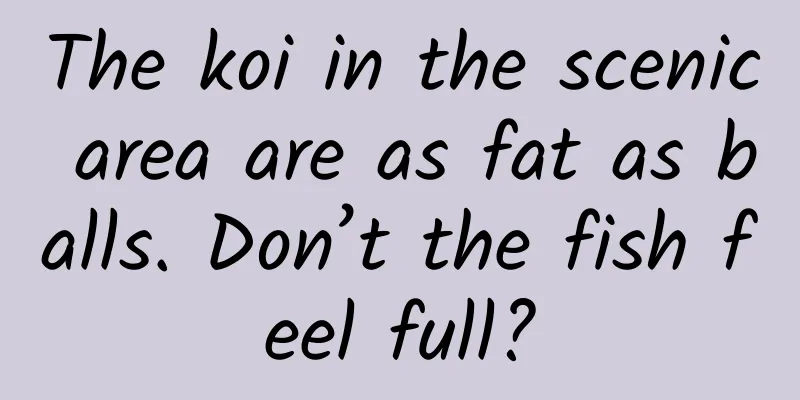The koi in the scenic area are as fat as balls. Don’t the fish feel full?

|
Audit expert: Wang Lei National Parks and Conservation Areas Researcher, PhD in Ecology During the past summer vacation, scenic spots were crowded with people, which also gave the koi in many scenic spots "special care". People took out food to feed the koi in the water out of their love for animals, the need to pray for blessings, and the yearning for interactive experience. As a result, the fish became visibly rounder. The picture comes from the Internet "The koi in Baotu Spring are fed at least three kilograms of food every day!" said a staff member. With so many people feeding them, will these fish really eat continuously? Don't they feel full? Maybe the fish's memory is really only 7 seconds, and they don't even know how many meals they have eaten? What kind of fish is Koi? Koi is a species of carp in the genus Cyprinidae that has been domesticated, genetically modified and selected by humans for a long time. The "four major fishes" we often refer to are black carp, grass carp, silver carp and bighead carp. In the long history of co-evolution between us and fish, humans think that these four fish have the most economic value. Koi is the most concentrated embodiment of "ornamental value". Koi scales have various colors and types, and their body color is affected by pigment cells, which can present rich color changes. Therefore, they are known as the "king of ornamental fish", and are also called "living gems" and "swimming works of art". Koi is auspicious and is said to bring good luck to its owner, so it has become a popular Feng Shui fish and ornamental pet. The picture comes from the Internet Koi have strong adaptability and a gentle temperament. They like to live in the middle and lower water layers with slow currents and deep water bodies, and forage in the mud and sand. Carp is an omnivorous aquatic creature, and koi is a typical eater of both meat and vegetables. In the natural environment, koi like to eat aquatic insects and algae, but in artificial breeding, they, like some of us humans, are particularly fond of carbohydrates and sweets. Can fish sense when they are full? The digestive system of fish is relatively primitive. Simply put, it can be divided into two categories: fish with stomach and fish without stomach. As the name suggests, fish without stomach do not have a "stomach" structure in their digestive tract. Some fish do not have differentiation between large and small intestines, and do not even have a strict distinction in digestion and absorption functions. The digestive tract can only be roughly divided into three parts: front, middle, and back. The carp and goldfish we are familiar with are fish without stomach. Image source: Biology Online Classroom Because the digestive tract of stomachless fish is relatively smooth, when there is a lot of food, the food they eat will push the feces out, so they will poop faster. Therefore, they tend to eat a little more. For fish with stomachs, the stomach is the largest part of the digestive tract. It can secrete digestive enzymes such as proteases and is an important digestive organ. Generally, fish with stomachs are carnivorous and ferocious fish. They can use their stomachs to better sense "fullness" and eat in moderation. The feeling of fullness in fish without stomach is much slower than that of fish with stomach. But this does not mean that it cannot feel full. It will stop eating when its intestines are full of food. Fish only have a memory of seven seconds? In fact, fish's memory is much longer than 7 seconds. In the 1960s, American scientists studied the memory of goldfish and found that goldfish can remember the "light-avoidance" behavior pattern for up to a month. In addition to goldfish, paradise fish can remember "strange neighbors" they have seen before and keep it for several months. After training, zebrafish can learn to distinguish feeding time according to the color of signal lights, learn how to walk through mazes, etc. Ornamental fish in the pond will quickly swim over and spit bubbles when someone approaches them one day, trying to get food. This is also a memory stimulated by food. Therefore, the koi fish will not forget that it had eaten just a few seconds ago. Try not to feed the fish in the scenic area It can be seen that omnivorous koi are indeed greedy and eat unscientifically. The reason why they become unhealthily "fat as balls" after being fed is that the food we feed them now is food that they have not consumed and digested in large quantities in their natural environment and in the long process of biological evolution. Although koi are not incapable of feeling full and will not forget whether they have eaten, we should try not to feed them when we visit scenic spots. Improper feeding can easily harm fish and even cause death. This also comes back to the fish's digestive system. First of all, the main function of fish teeth is to attack prey and tear food apart, and they are generally equipped on carnivorous fish. Omnivorous and herbivorous fish rarely have teeth, and those that have teeth only have a cutting function. All fish teeth have no chewing function, or in other words, they cannot chew food. These large pieces of food that have not been ground will enter the fish's intestines through the fish's extremely short esophagus. The fish's digestive ability is much worse than we think. Some foods not only cannot be digested, but will scratch the fish's digestive tract. Damage to the digestive tract will have a great impact on the fish's health. The picture comes from the Internet Generally speaking, for fish without stomachs, such as koi, the principle of "feeding small amounts frequently" should be adopted. Large or sharp food pieces, feeding too much at one time, or feeding at irregular times can damage the fish's digestive tract or put too much pressure on the digestive tract. Some fish food will swell when it absorbs water, so you should not feed too much at one time. Another important cause of death is that the fish are fed too much food and fail to finish eating it. As a result, the food rots and deteriorates in the water, affecting the water quality. The worst thing is that the decay process consumes the oxygen in the water, making the living conditions of the fish worse. So, facing the koi swimming leisurely in the water, we can watch, take pictures, and make wishes, but it is best not to feed them to disturb them~ References Dawanglu "The koi in China's scenic spots have higher blood lipids than Shanxi people." Scientific rumor-busting platform "Scientific rumor-busting | Rumor warning! Fish "don't know when to be full" and get stuffed to death?" Guokr: "Do fish really only have a 7-second memory?" Science Popularization China "Does a fish's memory last only 7 seconds? What's even more interesting is..." |
>>: Do you have memory problems? 6 ways to improve your memory →
Recommend
I want to learn Baidu bidding promotion. Are there any recommended Baidu bidding promotion tutorials?
The most taboo for novices learning Baidu bidding...
Breaking news! Apple Store made major adjustments and many apps were cleared of keywords. What is the reason behind this?
Breaking news! The Apple Store has undergone majo...
Weibo Fans Advertising Case Study: Beauty and Plastic Surgery Industry!
Shanghai Mylike is the earliest group enterprise ...
Feeling sleepy right after eating? You have been officially diagnosed with "carbon dizziness" on the Internet...
After a big meal, you feel sleepy Lying in bed an...
Baidu Ai Procurement operation skills, how to operate Baidu Ai Procurement?
What is Baidu's most popular promotional prod...
A new key component in the new energy vehicle competition, is it possible for China's new energy vehicles to overtake others?
Just as the engine, gearbox and chassis are the t...
David Ogilvy's 20 Most Valuable Advertising Rules!
If a Chinese advertiser only knows the name of on...
2018 Baidu Smart Mini Program Open Course Starts! Hundreds of Billions of Traffic Benefit Developers
On December 13, 2018, Baidu Smart Mini Program Op...
Share this with your family and friends! 30 things you need to know about the new coronavirus
▌Source : CCTV News WeChat Official Account (ID: ...
10 steps to planning an event, and 5 key points to focus on
To plan a high-quality event, operators need to h...
How can you pay by just tapping?
Have you used the new “touch and pay” feature of ...
Isn't it enough to just wash the cutting board? Why can't you reuse it?
ps. In addition to not mixing cutting boards, you...
LeTV Super Phone 2 review: a small TV with mobile phone functions!
The performance of LeTV Super Phone 2 will give p...
These are the real "ice cream assassins", be careful!!!
Since the beginning of summer, the State Administ...
Produced by Tencent! Popularization of 7 Human-Computer Interaction Design Models
As we all know, human-computer interaction is a d...









